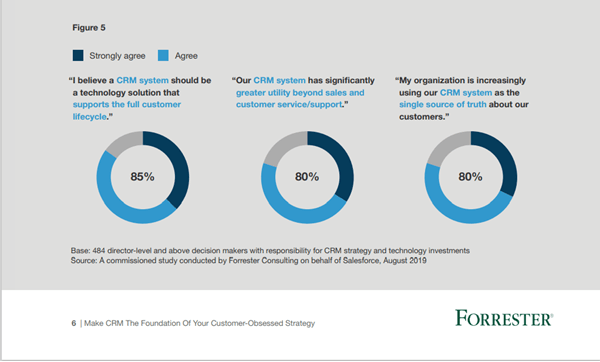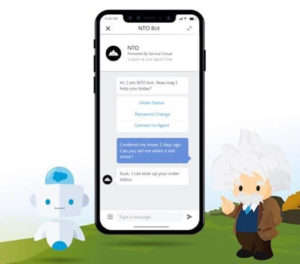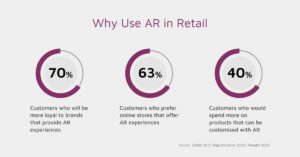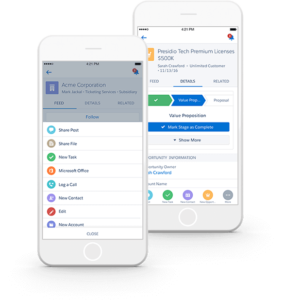What does the future of CRM hold for the next 5 to 10 years?
By 2027, the CRM trend is expected to reach $113.46 billion. (Fortune Business Insights, 2020)
During the same period, it is projected to grow at a CAGR of 14.2%. (Grand View Research, 2020)
Digital leaders, who are up-to-date with tech and CRM trends are already ahead in their game and outperforming other organisations by 5x in revenue growth! To harness the power of CRM systems, one requires a mastery of knowledge in related technology and ongoing CRM trends.
Technology is ever evolving and what our CRM enthusiasts thought would be trending in 2021 has shifted towards new inclination for 2022 and we will be explaining all that in this blog.
Without further ado, here are 7 upcoming CRM trends that will define its future for 2022 and beyond.
1. CRM as the single source of truth
For 2022 and beyond, it is projected that CRM platforms will be used as a single source of truth. By combining and synchronising data from disparate systems such as legacy CRM, excel sheets, within an organisation, CRM will be an all-in-one intuitive single location with 360-degree holistic view.
A survey from Forrester showed that 80% of business leaders believed that “a single source of customer truth would create ‘significant’ or ‘indispensable’ value for the company” and will upgrade their CRM as the sole source of information, free from errors helping them make data-driven decisions to better serve, and retain customers, generate and nurture more leads.

2. Big-data, AI and CRM will merge
According to Gartner’s 2019 CIO Agenda survey, 14% of global CIOs have already deployed AI, and AI powered CRM software will be on demand to enhance the global revenue by the end of 2021 and beyond.
Data is the new oil of the digital economy. Hence the success of CRM will now rely heavily on big-data. Advanced CRM tools will utilise large data sets to identify human patterns, track contacts and leads, their trends, and how they interact to better understand clients and deliver personalised experience. The integration of AI will be on rise as machine learning tools will be used to boost your predictive lead scoring and make correct sales predictions.
Furthermore, text mining (the method of transforming unstructured text into a structured form to identify meaningful patterns and new insights), and chat bots (natural language processing) and data-driven analytics will be integrated into CRM that will increase your ROI and conversion rate. Two such all-in-one platforms adopting AI are – Dynamics 365 (embedded intelligence) and Salesforce (Einstein).
Watch how Microsoft uses AI in Dynamics 365 for Sales & Marketing:
3. Voice Technology enabled CRM
The speech and voice recognition market is expected to grow from USD 8.3 billion in 2021 to USD 22.0 billion by 2026; it is expected to grow at a CAGR of 21.6%, (MarketsandMarkets™,2021).
We predict that the on-premises speech and voice recognition systems will be deployed with company data management and CRM software in years to come. Consequently, the customer service and sales team can use voice to better track conversations with clients, update all the data, send auto voicemails, and engage with them 24/7.
Watch how Salesforce Service Cloud Voice uses intelligent telephony to increase agent productivity and better serve customers.
With voice technology, CRM will be a living, breathing interactive platform that will change the status quo of engagement with customers since they want conversations and responsive assistants that carry out real-time personalised action.
4. Self-service with chatbot integrated CRM
69% of decision makers at service organisations say self-service is a major part of their service strategy.” -State of Service, Salesforce Research, 2019.
Customers want their problems solved quickly. The most important attribute of the customer experience is a fast response time. Self-service is no longer an added benefit but a must-have feature to provide positive customer experience.
With self-service, customers get their questions clarified fast. As automation is escalating with CRM, bots are completing more contact management tasks, and saving team members time to focus on tasks that matter the most, while saving resource cost for the company.

Chatbots offered by platforms like Salesforce automatically supervise prospects through marketing and sales pipelines by collecting data, probing questions, and presenting more personalised content.
5. New customer journey with Augmented and Virtual Reality
AR and VR are increasingly becoming popular in experiential marketing and CRM with these technologies will give businesses the edge for next level customer engagement. Research from BigCommerce,2020 showed 61% of consumers now prefer online stores that offer AR experiences while ZDNet, 2021 found 70% of consumers are more loyal when the stores have AR technology embedded.

With the cutting-edge AR and VR technology, businesses can unlock a new dimension to digital and physical interactions (for instance shopping) where products, services ,and experiences are brought to life, unlocking new doors for customer journeys which companies can leverage in their favor.
Watch how Microsoft Dynamics 365 Product Visualie uses mixed reality to help sellers meet customers’ needs faster and better.
6. A momentum in Mobile and Social CRM
For the year 2022, we can foresee that more CRM systems will offer full mobile functionality in different devices like smartphones, and tablets, giving the power of customer success in the palm of our hands.
CRM platforms such as Microsoft Dynamics 365 and Salesforce are planning to integrate more social networks into their CRM, aiming to boost their employees’ productivity. Advancements in mobile technology and customers’ increasing need for constant connectivity indicate a push for CRM platforms to provide more mobile functionalities.

These enhancements and integrations will offer a well-packaged functionality without compromising the security of user data.
7. Customer Experience (CX) will boom
Did you know joint research from Forbes and Salesforce showed that Customer Experience (CX) is on the top-five list of priorities for more than 65% of executives and leaders for the next three years! CX is definitely rising as the king and all the C-suite are emphasising more on enhancing the customer experiences knowing that these are the key brand differentiators when it comes to a competitive edge in the market.
It’s not just the C-Suite emphasizing CX. Consumers agree, according to a 2020 Salesforce survey, where 80% of respondents ranked experience as important as products or services. Shep Hyken, the top Customer Service Expert, CAO (Chief Amazement Officer) of Shepard Presentations, LLC identified two drivers of an exceptional experience: convenience and competition.
Hyken stated, “The company that’s easiest to do business with is ultimately going to win.”
What’s Next for CRM?
Experts at Dogma predict that there will no longer be standalone CRM systems, but comprehensive productivity and holistic solutions for sales, marketing, and customer services. We stress that these integrated tools will have more capabilities, shifting from output-driven tools to more efficiency-driven, productivity-driven and customer-centric tools. It might no longer be identified as a CRM, rather a “customer, sales and marketing enabler” powered with key data and insights to make better business discussions and drive more ROI.
Moreover, when it comes to choosing the best-fit CRM, most businesses want to invest in the two of the top market leading CRMs- Microsoft Dynamics 365 and Salesforce. But without expert consultation, choosing between them can leave you in a quandary.
As your trusted advisor, here’s an on-demand webinar recording on “Salesforce vs. Dynamics: Where do their strengths lie” that will lift up the fog in making the right choice for your business needs.
Understand the two, how they differ, strengths, plus recent developments and direction of travel.


